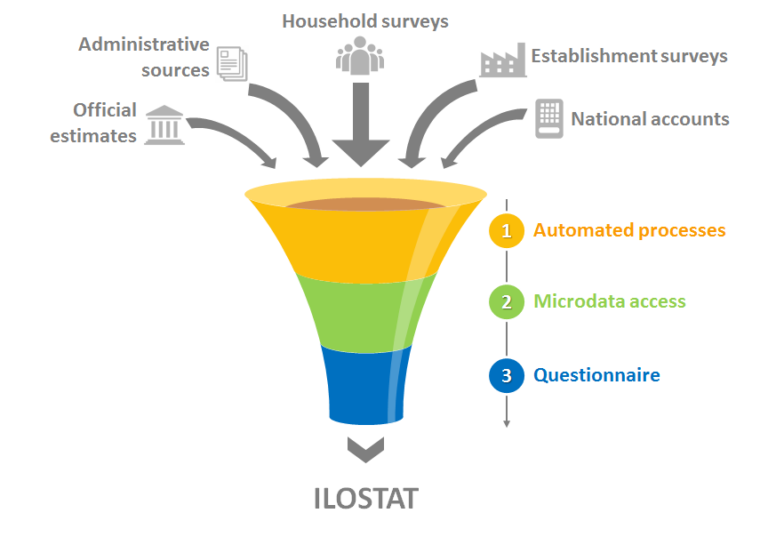ILOSTAT provides users with comprehensive international data across a wide range of labour-related topics. But how does the ILO collect and compile all these data? Three main methods are used: microdata processing, automated data collection, and the annual ILOSTAT questionnaire. In addition to these, the ILO produces modelled estimates and projections for selected indicators.

Microdata
The ILO collects the underlying household survey datasets (mostly labour force surveys) compiled by national statistical offices around the world. We currently have more than 11,700 household survey datasets across 161 countries. After we collect the datasets, ILO experts systematically process them to generate harmonized indicators based on international statistical standards. This allows us to produce and publish a wide range of detailed and internationally-comparable labour statistics. These figures may differ from those that are nationally reported. The magnitude of the differences depends on the extent to which a country is applying international statistical standards.
We also leverage the ILO Harmonized Microdata collection to respond to ad-hoc user queries for different data tabulations. Critically, our direct processing of national household survey datasets also provides the ILO with detailed information on national survey practices, which we use to better inform ILOSTAT users about the data they’re using and to provide technical support to countries to help them improve their surveys.
Learn more

ILOSTAT Microdata Processing Quick Guide: Principles and methods underlying the ILO’s processing of anonymized household survey microdata
This Quick Guide (last updated in September 2024) presents the anonymized microdata processing undertaken by the Data Production and Analysis Unit in the ILO Department of Statistics. It describes why and how the unit carries out this activity, as well as the potential expansion of this work. It also mentions considerations and limitations to take into account by data users.
Automated processes
In recent years the ILO has devoted extensive resources to automate how it collects and processes data from national statistical offices around the world. Automation allows us to collect data more efficiently and to publish more and higher-quality data, all while reducing the reporting burden for national data providers. Our automation processes include systematizing the collection of data from a wide variety of online data repositories and reshaping, reprocessing and validating the data before publishing on ILOSTAT.
Questionnaire
The annual ILOSTAT questionnaire remains an important data collection tool to obtain information for countries with limited dissemination platforms as well as non-household survey data, which are often unavailable online. The Excel-based questionnaire is sent out each year to national statistical offices and labour ministries worldwide. They receive a link to a statistics reporting portal with not only the questionnaire to be completed, but also information concerning the data collection, such as a list of contacts and an overview of data availability by indicator. The annual response rate to the questionnaire is typically around 50 per cent of member States, which cover about 80 per cent of the world’s population.
See also

Reporting labour statistics to the ILO
Information for data producers to report their labour statistics to the ILO.
ILO modelled estimates and projections
The ILO modelled estimates data series is the world’s largest repository of internationally comparable national, regional and global estimates of key labour indicators. The series includes estimates of labour force participation, employment (including disaggregations by economic activity, occupation, economic class and status in employment), unemployment and labour productivity, among others. The starting point to produce each indicator in the series is a careful review of input data to ensure that only internationally comparable data are included. After this, a number of econometric models are used to produce estimates where data are unavailable, and to provide future projections where feasible. The full coverage and strict comparability of the series helps to provide insights into global and regional labour market trends. It is also a main source for SDG reporting at the global and regional levels.
